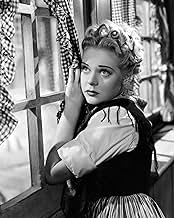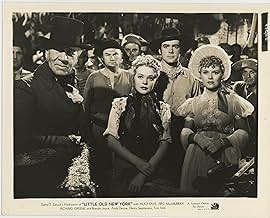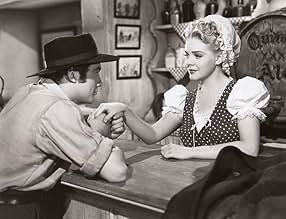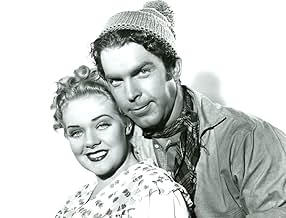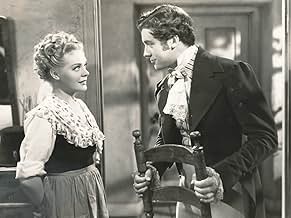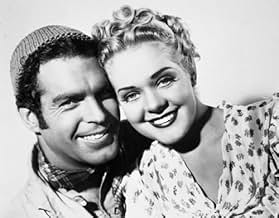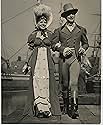VALUTAZIONE IMDb
6,4/10
277
LA TUA VALUTAZIONE
Aggiungi una trama nella tua linguaSteamboat inventor Robert Fulton shows up in New York in 1807. Tavern keeper Pat O'Day believes in him, but her boyfriend doesn't. All seems lost after sailors, afraid of losing their jobs, ... Leggi tuttoSteamboat inventor Robert Fulton shows up in New York in 1807. Tavern keeper Pat O'Day believes in him, but her boyfriend doesn't. All seems lost after sailors, afraid of losing their jobs, burn his boat.Steamboat inventor Robert Fulton shows up in New York in 1807. Tavern keeper Pat O'Day believes in him, but her boyfriend doesn't. All seems lost after sailors, afraid of losing their jobs, burn his boat.
- Regia
- Sceneggiatura
- Star
Clarence Wilson
- Willie Stout
- (as Clarence Hummel Wilson)
Theodore von Eltz
- Washington Irving
- (as Theodore Von Eltz)
Oscar 'Dutch' Hendrian
- Blackie
- (as O.G. Hendrian)
Recensioni in evidenza
I only saw this film in the 1960s, and memories of it are somewhat sparse. I recall Richard Greene trying to get financing for his steamboat, and finding roadblocks by various troublemakers, mostly local sailors who realize that steam power will hurt their sail oriented business. One moment that was well handled is the burning of the original "Claremont" (the actual name of the boat was "the North River Steamboat of Claremont" - Claremont was the name of the country estate of Chancellor Robert Livingston, Fulton's backer and brother-in-law). Another moment of the film was Greene's confusing meeting with Victor Killian, introduced to him as "Mr. DeWitt" (Greene thinks it's DeWitt Clinton - Killian is actually a thug trying to create a scene in which Greene can be beaten up). Alice Faye is given a song or two to sing, and is the love interest of MacMurray (who is also momentarily jealous of Greene, but still supports the steamboat at the end).
If one is really interested in the story of this invention - our first really important invention in the industrial revolution - read James Flexner's "Steamboats Come True". The actual first inventor was John Fitch, who made a successful steamboat that ran to and from Philadelphia in 1790 - 1792). Fitch was clever, but he did not know how to make a plan of the invention that could enable him to rebuild a second working steamboat. It was a hit or miss thing with Fitch. In 1798 he committed suicide in Kentucky. Besides Fitch there were other inventors (Oliver Evans, James Rumsey), but Fulton had engineering training, and was able to make patents that could be followed to repeat his invention again and again. So 1807 is the year we usually credit for the invention of the steamboat.
Yet oddly enough this is the only sound film of Fulton's invention that was made in Hollywood. I suspect it is because the Claremont was a prototype that lacked the glamor of later vessels (those that plied the Mississippi River from 1828 - 1900), and that (with a few tourist exceptions) no longer matters to us. More films dealing with railway and car transportation have been made - even more about aviation and submarines. So I suspect there will never be a more solid look at Fulton's career as artist, submarine pioneer, and steamboat developer. There is another film where Fulton pops up: "Austerlitz", a French film made in the 1950s where Orson Welles appeared as Fulton trying (in 1804-05) to interest Napoleon I in his submarine. That's about it. Maybe one day a serious film on Fulton will be made. Until then we have "Little Old New York".
If one is really interested in the story of this invention - our first really important invention in the industrial revolution - read James Flexner's "Steamboats Come True". The actual first inventor was John Fitch, who made a successful steamboat that ran to and from Philadelphia in 1790 - 1792). Fitch was clever, but he did not know how to make a plan of the invention that could enable him to rebuild a second working steamboat. It was a hit or miss thing with Fitch. In 1798 he committed suicide in Kentucky. Besides Fitch there were other inventors (Oliver Evans, James Rumsey), but Fulton had engineering training, and was able to make patents that could be followed to repeat his invention again and again. So 1807 is the year we usually credit for the invention of the steamboat.
Yet oddly enough this is the only sound film of Fulton's invention that was made in Hollywood. I suspect it is because the Claremont was a prototype that lacked the glamor of later vessels (those that plied the Mississippi River from 1828 - 1900), and that (with a few tourist exceptions) no longer matters to us. More films dealing with railway and car transportation have been made - even more about aviation and submarines. So I suspect there will never be a more solid look at Fulton's career as artist, submarine pioneer, and steamboat developer. There is another film where Fulton pops up: "Austerlitz", a French film made in the 1950s where Orson Welles appeared as Fulton trying (in 1804-05) to interest Napoleon I in his submarine. That's about it. Maybe one day a serious film on Fulton will be made. Until then we have "Little Old New York".
This film sports winning performances (Alice Faye is delightful and very accomplished as a light comic actress), plenty of well-played comedy and well-staged action, a fine Alfred Newman score. But what really impressed and intrigued me were some elaborately staged outdoor scenes which appeared to be at least partially shot on a real 18th century seaport, not just the back lot. Either Fox spent a whole lot of money constructing a very large and realistic looking seaport set, or some of this was shot on location at some historic recreation site, or the art director was a genius in making the back lot look a lot bigger than it was. Interesting to see what a muscular hunk Fred MacMurray was, very different than his image in later years.
Though it probably has zip to do with the actual story of Robert Fulton and the invention and manufacture of the first steam engine this is a very pleasant little drama with light overtones. That's mainly due to the cast, all very competent performers who have a nice chemistry together.
Alice Faye, not singing this time, is full of brassy snap as the most virtuous waterfront innkeeper who never existed who longs to leave the docks behind and become a lady. She's matched by Fred MacMurray full of cheery bonhomie as a shipbuilder, the now amusingly named Charley Brownne, who has a yen for Alice. Richard Greene is a bit of a stick as Fulton but he and Brenda Joyce make an attractive pair. And Andy Devine is along to add his squeaky voiced charm as a buddy of the lead pair.
The title, an obvious attempt by Fox to conjure up thoughts of Alice's big hit of a few years before, In Old Chicago, has very little to do with the picture. You hardly see any outdoor shots of the city but the interior sets are handsomely mounted if unimaginatively lit as you'd expect for a Fox feature for their top star.
If you're looking for a history lesson about the progress of navigation during the country's early years you won't find it here but if a enjoyable diversion for about an hour and a half is what you seek this will fill the bill. Nothing spectacular but a nice hidden gem for fans of the stars.
Alice Faye, not singing this time, is full of brassy snap as the most virtuous waterfront innkeeper who never existed who longs to leave the docks behind and become a lady. She's matched by Fred MacMurray full of cheery bonhomie as a shipbuilder, the now amusingly named Charley Brownne, who has a yen for Alice. Richard Greene is a bit of a stick as Fulton but he and Brenda Joyce make an attractive pair. And Andy Devine is along to add his squeaky voiced charm as a buddy of the lead pair.
The title, an obvious attempt by Fox to conjure up thoughts of Alice's big hit of a few years before, In Old Chicago, has very little to do with the picture. You hardly see any outdoor shots of the city but the interior sets are handsomely mounted if unimaginatively lit as you'd expect for a Fox feature for their top star.
If you're looking for a history lesson about the progress of navigation during the country's early years you won't find it here but if a enjoyable diversion for about an hour and a half is what you seek this will fill the bill. Nothing spectacular but a nice hidden gem for fans of the stars.
In this historical drama, Richard Greene stars as the designer of the steamboat. At first, no one's interested enough to finance his project, but with the help of his new friends, the low class but tenacious Fred MacMurray and Alice Faye, he shows his model to more and more people. Added into the mix are brawny bully Ward Bond, silly sailor Andy Devine, and Ben Carter, Alice's hired hand whom she treats terribly and always accuses of stealing drinks.
A warning for all Alice Faye fans: it's just as obvious that she's out of Richard's league as it is that she's falling in love with him, and it's a bit sad. Richard falls for Brenda Joyce and her wealthy uncle Henry Stephenson, who's financing his steamboat. Alice looks very cute in this movie, and it's not fun to see her getting her heart broken over a fellow who isn't worth it-which, let's face it, is the only type of fellow who goes around breaking hearts. Also, this isn't a musical, and the only song, "Who Is the Beau of the Belle of New York," is sung and danced to during an outdoor celebration. It's a very cute song, but so brief that this movie qualifies as one of Alice's only non-singing roles.
A warning for all Alice Faye fans: it's just as obvious that she's out of Richard's league as it is that she's falling in love with him, and it's a bit sad. Richard falls for Brenda Joyce and her wealthy uncle Henry Stephenson, who's financing his steamboat. Alice looks very cute in this movie, and it's not fun to see her getting her heart broken over a fellow who isn't worth it-which, let's face it, is the only type of fellow who goes around breaking hearts. Also, this isn't a musical, and the only song, "Who Is the Beau of the Belle of New York," is sung and danced to during an outdoor celebration. It's a very cute song, but so brief that this movie qualifies as one of Alice's only non-singing roles.
Nothing deep, but an interesting Hollywood-ized account of the development of steam propeled ships. Imagine... being able to propel a vessel upstream even into the wind! But at what risk? The current economy's support? And how do you pay for the thing?!?! Additionally, you have a young country out to protect its interests... but what if it acted Isolationistically? Would you be able to pursue your dreams? If the overdeveloped subplots of "Sink the Bismark" did'nt offend your sensibilities greatly, you will enjoy this yarn.
Lo sapevi?
- QuizThe play opened on Broadway in New York City, New York, USA on 8 September 1920 and closed in June 1921 after 303 performances. The opening night cast included Genevieve Tobin as Pat O'Day, Douglas Wood, as Cornelius Vanderbuilt and Donald Meek.
- BlooperThe hairstyles of the women are from the time the film was made, not from the early 1800s.
- ConnessioniReferenced in La via delle stelle (1940)
- Colonne sonoreWho Is the Beau of the Belle Of New York
(1940) (uncredited)
Music and Lyrics by Mack Gordon
Performed by Tyler Brooke and joined by Alice Faye and other dancing patrons of Krausmeyer's Pavillion
I più visti
Accedi per valutare e creare un elenco di titoli salvati per ottenere consigli personalizzati
Dettagli
- Data di uscita
- Paese di origine
- Lingua
- Celebre anche come
- Little Old New York
- Luoghi delle riprese
- Azienda produttrice
- Vedi altri crediti dell’azienda su IMDbPro
- Tempo di esecuzione1 ora 40 minuti
- Colore
- Proporzioni
- 1.37 : 1
Contribuisci a questa pagina
Suggerisci una modifica o aggiungi i contenuti mancanti

Divario superiore
By what name was I ribelli del porto (1940) officially released in India in English?
Rispondi
